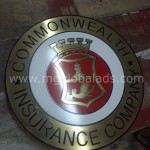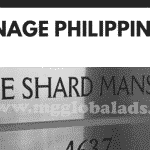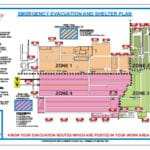Making your Mark with Laser Engraving
Signs are an important part of any business. It is in the frontlines of marketing for any retail business, and it distinguishes the established from the fly-by-night outfits. The quality of the signage is therefore a crucial consideration, and one of the most popular types is using laser engraving.
Why laser engraving?
Laser engraving has many benefits for the sign maker as well as the sign owner. It is non-contact, so there is no wear and tear on the tools used. The markings are clear and crisp whether it is the first or the 1,000th sign made. The equipment is very user friendly and easy to use. It is also very precise in conjunction with computer software (which is always), and this allows the inclusion of fine details that is often lost with other marking methods.
How it works
The most common type of laser engraving uses a CO2 laser. This uses a beam of light to deliver concentrated energy, enough to fracture or heat up a tiny area of the surface, and effectively cutting it. The area over which the laser beam passes depends on how it is controlled. This can be manual using a handheld laser, or automated, using computer software. In industrial settings, the laser engraver uses computer software for precise and consistent results.
Materials
Laser engraving is a very fast method for engraving , and most importantly, works on virtually any type of surface and materials. Laser engraving is not only good for signs; it also works on plaques, glass, and other branding collaterals.
Acrylic
Perhaps the best material for laser engraving is acrylic. It is a manmade material with many features in common with glass, but it is far more durable and flexible. It also works very well with lasers, and requires no pre- or post-processing. This is a big advantage for sign makers that handle a lot of customized orders and intent on producing excellent results.
Acrylic engraving results in a frosty white color and a polished edge not seen in other materials. It also comes in a variety of colors, textures, and thicknesses, so the sky is the limit when it comes to customization. When illuminated with lights, the engraving seems to float, which is what you want to happen. Edge lighting using LED is particularly effective in creating different effects in the hands of an experienced sign maker. You can have a glazing effect, or a 3D effect, which are not possible in anything but acrylic engraving. For best results in light transmission, the recommended type of acrylic is Lucite.
However, the effects you can achieve with acrylic depend on the processing used to produce the material. You have either cast or extruded acrylic. Cast acrylic has a white, frosted appearance when laser engraved, while extruded acrylic has a clearer look. Extruded acrylic is faster to work with, but cast acrylic usually lends itself to techniques that are more complex. Overall, cast acrylic is a better material for signs while extruded acrylic is better for other purposes. Either type of acrylic can achieve a visually appealing impact with the proper settings and under an experienced hand.
Laser engravers are also an excellent method for cutting sign shapes out of acrylic, especially when joining signs together. Lasers provide consistent and accurate results quickly and easily, enabling them to line up closely. Laser engravers are also very useful when subsurface graphics are required, such as when creating directories, by using a burn through technique. This produces white text against a colored background without the hassle of cutting each detail individually into the colored surface.
Metals
While acrylic is the best material for laser engraving, other materials also lend itself to unique results under the attention of a laser. Laminates are particularly good for adding inlaid details to wood or glass, taking the place of traditional inlay materials such as mother-of-pearly, which are more expensive and more expensive to work with.
You can also use lasers to mark metals, although typical CO2 lasers require priming the metal surface with a marking compound. Brass engraving for nameplates, for instance, requires this extra step unless the sign maker has multi-wavelength laser equipment. If that is the case, there is no need for the marking compound. The same applies for stainless steel engraving.
Aside from brass and stainless steel, other popular metals for laser engraving are copper and aluminum, although most metals will also work well. Different lasers have different capabilities. When using a fiber laser, for example, you can produce different colors without using any ink, by adjusting wave form, frequency, wave length and focus provided the metal has high carbon content such as carbon steel, titanium, and cast iron. You will not get the same color effect on brass, copper, and aluminum. This is because the laser anneals the carbon in the metal, making a rich, dark mark. An added bonus of this feature is that annealing prevents the growth of bacteria.
Wood
Wood is also another material you can use with laser engraving. The laser can mark cleanly, or you can adjust the focus to create a charred effect. The nice thing about using lasers on wood is that there is very little clean up involved, as opposed to traditional methods of carving wood, especially if you mask the wood prior to marking. The laser simply cuts through the tape, but the tape keeps resins and dust from flying any which way.
Glass
Laser engraving is also a great way to create personalized drinking glasses such as champagne flutes, bottles, wedding giveaways, and picture frame glasses. You don’t need any special equipment for engraving on a flat surface such as pane of glass, but you may need a special fixtures for engraving on cylindrical surfaces such as a champagne flute. Since only the laser beam touches the glass, you will not have to worry about water-cooling.
The appearance of laser engraving on a glass surface is distinctive from other types of engraving method, such as a rotary engraver. Because it essentially fractures the surface on the microscopic level, it can leave behind very tiny chips or flakes along the edges of the cut, which may give it a slightly uneven appearance. It is also impossible to engrave glass deeply when using lasers. In addition, the type of glass can affect the precision and ease of laser engraving. Glass containing a significant amount of lead, for instance, heats up more that other types of glass. This can cause it to flake or chip in excess, or even shatter under a laser. Some engravers use lasers to engrave a metal stencil, and using that as a guide, use a sandblaster to engrave the glass.
Leather, fabric, and paper
Laser engraving comes up trumps when the material in question is leather, fabric or paper. It works very well on all types of leather and fabric as long as it fits in the laser equipment. You can create leather appliqués quickly, easily, and consistently, and create designs on bags, checkbook covers, belts, footballs, saddles, and briefcases. This is an excellent way to brand your leather and fabric collaterals and products.
Laser engravers are also useful for cutting paper products for jigsaw puzzle pieces, mat boards, photographs, greeting cards, and stationary. It is also very useful for creating labels, imprinting bar codes, and tags for your products. The next time you are producing something like this for your business, you may be able to tap your local sign maker to do the cutting for you. The only limit is your design and imagination.
Other materials
Other uses of laser engraving are for personalizing jewelry and other metal products such as pens. Most of these are used for promotional purposes, and will have a distinct benefit for many businesses. Some entrepreneurs use a low powered table top version of the CO2 laser to produce customized pendants, or to engrave names and dates inside ring bands, but these usually have very limited capacities.
Artwork
Quite a few artists are using laser engraving technology to create works of art on any of the materials described above. Some use lasers manually to cut into the material to reveal striations or other features, or fill the grooves with ink, glazes, or other materials to create a unique surface. Others upload a design to the computer and use software to engrave their chosen surface.
Conclusion
Laser engraving used to be limited to big industries because of the investment involved in one of these machines. Technological development has made it possible to use laser as a quick, affordable, and efficient method to mark materials for various purposes. In terms of signage, you now a myriad of options for commissioning high quality customized work for your business at a fraction of what it used to cost. For more information on laser engraving services, or to get a quote for your laser engraved signage or other branding collaterals, contact your local sign maker.
More from my site











